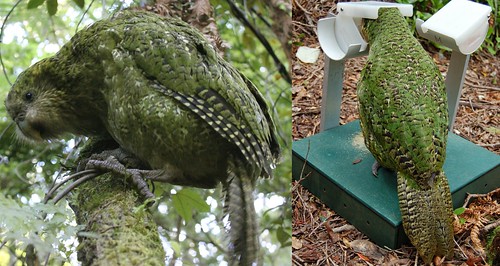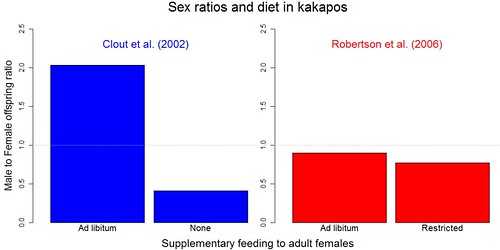Food for sex
 Monday, March 18, 2013 at 4:49
Monday, March 18, 2013 at 4:49  Kakapo are unique among the ~ 400 parrot species (Psittaciformes) for being flightless, nocturnal and extremely long-lived (up to 100 years!). Additionally, they are herbivorous (seeds, fruits, polen, plants), males can weigh up to 2-4 kg (40% heavier than females), and females lay their eggs on the ground or cavities – i.e., 3 eggs in a single clutch annually, although 2 clutches might occur if the nest fails at the beginning of the reproductive season or if the eggs are taken for artificial incubation.Native to New Zealand, kakapo once inhabited the subalpine fringes of forest and scrub. Polynesians (1000 years ago) and Europeans (mostly in the XIX Century) arrived in the archipelago accompanied by dogs, cats, rats and mustelids that cornered kakapo populations in the Fiordland region (south-west of the South Island) where it was declared extinct in 1989. In 1977, a population of some 200 individuals was found on Stewart Island - this population was already in decline to the claws and jaws of feral cats. By the 1980s, the failure of captive breeding programs prompted the transfer of 60 individuals from Steward to carnivore-free islands. The global (known) population ‘rocketed’ from 50 individuals in 1999 to 126 in the 2012 censuses and, consequently, the kakapo’s IUCN status changed in 2000 from ‘Extinct in the Wild’ to ‘Critically Endangered’. Under the management of the Kakapo Recovery Programme, kakapo are now present on the islands of Codfish, Anchor and Little Barrier.
Kakapo are unique among the ~ 400 parrot species (Psittaciformes) for being flightless, nocturnal and extremely long-lived (up to 100 years!). Additionally, they are herbivorous (seeds, fruits, polen, plants), males can weigh up to 2-4 kg (40% heavier than females), and females lay their eggs on the ground or cavities – i.e., 3 eggs in a single clutch annually, although 2 clutches might occur if the nest fails at the beginning of the reproductive season or if the eggs are taken for artificial incubation.Native to New Zealand, kakapo once inhabited the subalpine fringes of forest and scrub. Polynesians (1000 years ago) and Europeans (mostly in the XIX Century) arrived in the archipelago accompanied by dogs, cats, rats and mustelids that cornered kakapo populations in the Fiordland region (south-west of the South Island) where it was declared extinct in 1989. In 1977, a population of some 200 individuals was found on Stewart Island - this population was already in decline to the claws and jaws of feral cats. By the 1980s, the failure of captive breeding programs prompted the transfer of 60 individuals from Steward to carnivore-free islands. The global (known) population ‘rocketed’ from 50 individuals in 1999 to 126 in the 2012 censuses and, consequently, the kakapo’s IUCN status changed in 2000 from ‘Extinct in the Wild’ to ‘Critically Endangered’. Under the management of the Kakapo Recovery Programme, kakapo are now present on the islands of Codfish, Anchor and Little Barrier.
Inbreeding, system shocks caused by fire or cyclones (for example), or demographic stochasticity (by which two or more outcomes are possible) such as how many males and females will be born in a single year, are all factors that threaten the persistence of small and fragmented populations. They can, however, be reverted by conservation actions.
If you have ever taken dancing classes, you will be familiar with the scarcity of male partners and how this can jeopardize group learning. When reproduction, rather than salsapirouettes, is at stake, a biased sex ratio can compromise the persistence of species. For instance, when females are unable to find males (or vice versa), fertility rates can collapse as a result – a well-known cause of an Allee effect(1). Curiously, natural selection can promote such bias by favouring a species’ investment in litters dominated by one of the two genders. The evolutionary formulation of such scenario is that females can adjust the sex ratio of their offspring depending on the amount of available resources (2) – see contrasting cross-taxa studies on this subject (3-5). Thus, when resources abound (e.g., food), mothers can afford the offspring’s gender requiring more resources to reach adulthood or once adulthood is reached, is less likely to reproduce successfully (6). This predisposition to one gender or another can be key to the conservation of endangered species (7).
The kakapo case
At the end of the 1990s, the New Zealand Department of Conservation placed dispensers of supplementary food in the territories of some kakapo (a rather enormous, flightless parrot Strigops habroptilus) to encourage their reproduction. Back then, only 60 individuals were left of the entire species . Unfortunately, those females with access to the supplemental food conceived 67% of male chicks (so exacerbating the fact that kakapo populations are naturally male-biased), while those females without extra feeding had 71% of female chicks (8). Something wasn’t working.
 Sex ratios of kakapo chicks from mothers having access to ad libitum and restricted supplementary feeding on the islands of Codfish, Little Barrier, Maud and Pearl. Ratios >1 indicate predominance of male chicks, and <1 of female chicks (parity = 1, grey lines). To the left, the blue bars show sex ratios for adult females fed with an ad libitum supplement and females with no extra food, according to Clout et al. (8). To the right, red bars show sex ratios in clutches laid by females (< 1.5 kg at the end of winter) fed with an ad libitum supplement and females (>1.5 kg) with restricted supplementary food, according to Robertson et al. (10). Clearly, near parity resulted from diets adjusted to female body condition prior to mating.
Sex ratios of kakapo chicks from mothers having access to ad libitum and restricted supplementary feeding on the islands of Codfish, Little Barrier, Maud and Pearl. Ratios >1 indicate predominance of male chicks, and <1 of female chicks (parity = 1, grey lines). To the left, the blue bars show sex ratios for adult females fed with an ad libitum supplement and females with no extra food, according to Clout et al. (8). To the right, red bars show sex ratios in clutches laid by females (< 1.5 kg at the end of winter) fed with an ad libitum supplement and females (>1.5 kg) with restricted supplementary food, according to Robertson et al. (10). Clearly, near parity resulted from diets adjusted to female body condition prior to mating.
Assuming that diet regimes could alter sex ratios, and knowing that kakapo mums in excess of 1.5 kg often reproduced successfully (9),Bruce Robertson et al. (10) designed a field experiment to modify the body condition of females. From the end of the Austral winter (June 2001) to the start of reproduction (January 2002), the Kiwi team supplied ad libitum food in the territories of 8 females weighing less than 1.5 kg, and restricted supplementary feeding to 6 females over 1.5 kg. Following mating, all females were provided with ad libitum food, and their chicks were sexed. In a nutshell, the experiment showed that the 14 females monitored reached 1.8 kg at the end of winter and managed to lay a total of 15 clutches. This was during a good year for the species as a whole, with 67 eggs layed of which 26 chicks hatched and 24 fledged. The excellent news was that male:female ratios neared parity in both feeding treatments, namely 9:10 (ad libitumfeeding) and 7:9 (restricted feeding).
Kakapo reproduce in leks, that is, males engage in nuptial rituals of movement and vocalizations to impress females, and females choose the winners of the contest. Males then provide sperm, and thereafter females take full charge of bringing up the offspring. Looking at this reproductive strategy through three generations, those females that nurture the males which, as adults, will win the reproductive contests of their leks, secure the transfer of their genes to their grand-chicks. Therefore, a son is an advantageous (evolutionary) investment, but subject to the uncertainty of whether a given male will outcompete his rivals in mating. Kakapo females seem to take the risk of delivering more males when their body condition peaks, relative to food availability. The reversal of sex ratios, through variation in diet regimes, reflects the malleability of evolutionary processes that can thus aid the management of endangered species.
References
- Courchamp, F. et al. (1999). Inverse density dependence and the Allee effect.Trends in Ecology and Evolution, 14: 405-410
- Trivers, R. L. & Willard, D. E. (1973). Natural selection of parental ability to vary the sex ratio of offspring. Science, 179: 90-92
- Cassey, P. et al. (2006). Revised evidence for facultative sex ratio adjustment in birds: a correction. Proceedings of the Royal Society B: Biological Sciences, 273: 3129-3130
- West, S. A. & Sheldon, B. C. (2002). Constraints in the evolution of sex ratio adjustment. Science, 295: 1685-1688
- Ewen, J. G. et al. (2004). Facultative primary sex ratio variation: a lack of evidence in birds? Proceedings of the Royal Society of London. Series B: Biological Sciences, 271: 1277-1282
- Tella, J. L. (2001). Sex-ratio theory in conservation biology. Trends in Ecology and Evolution, 16: 76-77
- Wedekind, C. (2002). Manipulating sex ratios for conservation: short-term risks and long-term benefits. Animal Conservation, 5: 13-20
- Clout, M. N. et al. (2002). Effects of supplementary feeding on the offspring sex ratio of kakapo: a dilemma for the conservation of a polygynous parrot. Biological Conservation, 107: 13-18
- Elliott, G. P. et al. (2001). Intensive management of a critically endangered species: the kakapo. Biological Conservation, 99: 121-133
- Robertson, B. C. et al. (2006). Sex allocation theory aids species conservation.Biology Letters, 2: 229-231
 Strigops habroptilus - Kakapo | in
Strigops habroptilus - Kakapo | in  Conservation,
Conservation,  Research
Research 
